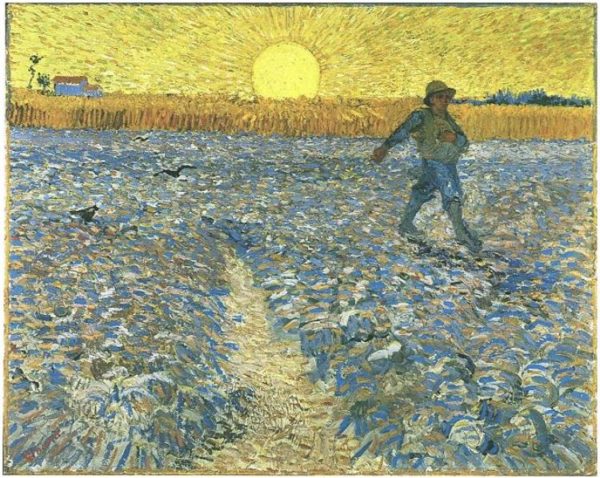And he told them many things in parables, saying: “A sower went out to sow. . . .” — Matthew 13:3 (ESV)
Today’s post on the Parable of the Sower and the Soils is the second in a series exploring Parables Jesus Told [1]. The first post, Entrusted . . ., considered the Parable of the Three Servants, or, The Talents (Matthew 25:14-30).

Introduction
Jesus’ parables are the best known, most engaging, and influential short teaching stories ever told. The Master Storyteller, built upon (and fulfilled) the law, the wisdom literature and the prophets of the Old Testament through word, life, miracle, and new life. The Gospel message pointed toward the world being right-side up.
Although the Messiah’s revolution against sin / darkness / devil — aimed toward establishing the Kingdom of God and the new creation (Mark 1:15) — appeared to fail when He died on the cross as a result of the . . .
- resistance of authorities (religious and governmental), family members, a member of the inner circle, fickle crowds, and the devil.
- the Father not saving His Son.
We find victory when the Son of Man . . .
- burst forth from the grave declaring that the new day / creation had come with God the Father’s blessing,
- commissioned His disciples to bring the Good News across the creation, and
- gifted the people of God with the power of the Holy Spirit.
The people of God were and continue to be sent forth in mission, with the call to love God and neighbor with head, heart, and hands, across the globe through the church, i.e., the very Body of Christ, through all aspects of life. We long for the Kingdom of God and the new creation to come in completeness. Come, Lord Jesus! Come!
The Parable of the Sower and the Soils
Read Matthew 13:1-9. Without looking at the interpretation in the text, what is Jesus’ main point in this parable? To more fully address the question, consider some of the larger context, i.e., Matthew 11-12. Furthermore, try to imagine yourself as an original listener (e.g., religious authority, disciple, adult in the crowd, child in the crowd, zealot). When doing such . . .
- What strikes you about Jesus’ relationship with religious leaders and the question of his true family?
- Do you think that his disciples will be able to follow his example? Why or why not?
Returning to the Parable of the Sower and Soils, how do you interpret / apply it in the original context?
Jesus interprets the parable in Matthew 13:18-23.
- Why?
- Who do you see your “self” to be in the parable?
- What are specific times when you are a sower (or should be sowing)?
- As a soil, are the seeds of faith sprouting forth, facing a challenge, being choked out?
- How did Jesus seek to change (or solidify) attitudes and behaviors with this transformative story?
In the educational journey, the faithful student perseveres. Yes, one embraces a long term investment. My prayer is that unlike the religious authorities in the Gospels, Emerging Scholars weave their faith and their vocation together. Such a life involves the head, heart, and the hands receiving the revolutionary seed sown by the Sower. Yes, embracing that which has been entrusted to them and not letting the pursuit of mind, power, reality, soul, space, time, and / or ego become primary. Stay tuned for more on the Parable of Sower and the Soils, Jesus’ use of parables as a teacher, an exploration of more parables.
To God be the glory!
Notes
[1] An adaption of a recent adult elective I taught at Elizabethtown Brethren in Christ Church. The title is taken from an excellent resource by David Allan Hubbard: Parables Jesus Told: Pictures of the Kingdom (Downers Grove, IL: InterVarsity Press, 1981). As for the definition of a parable, I appreciate the work of Klyne R. Snodgrass. He writes in Stories with Intent: A Comprehensive Guide to the Parables of Jesus (Grand Rapids, MI: William B. Eerdmans, 2008, 9), “In most cases then a parable is an expanded analogy used to convince and persuade.” I will give consideration to the definition of a parable in future posts.
Tom enjoys daily conversations regarding living out the Biblical Story with his wife Theresa and their four girls, around the block, at Elizabethtown Brethren in Christ Church (where he teaches adult electives and co-leads a small group), among healthcare professionals as the Northeast Regional Director for the Christian Medical & Dental Associations (CMDA), and in higher ed as a volunteer with the Emerging Scholars Network (ESN). For a number of years, the Christian Medical Society / CMDA at Penn State College of Medicine was the hub of his ministry with CMDA. Note: Tom served with InterVarsity Christian Fellowship / USA for 20+ years, including 6+ years as the Associate Director of ESN. He has written for the ESN blog from its launch in August 2008. He has studied Biology (B.S.), Higher Education (M.A.), Spiritual Direction (Certificate), Spiritual Formation (M.A.R.), Ministry to Emerging Generations (D.Min.). To God be the glory!

Leave a Reply